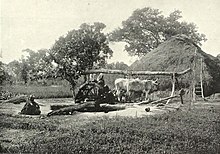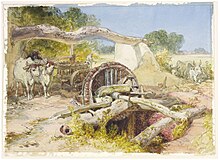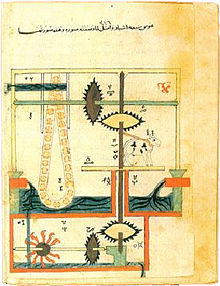

A sāqiyah or saqiya (Arabic: ساقية), also spelled sakia or saqia) is a mechanical water lifting device. It is also called a Persian wheel, tablia, rehat, and in Latin tympanum. It is similar in function to a scoop wheel, which uses buckets, jars, or scoops fastened either directly to a vertical wheel, or to an endless belt activated by such a wheel. The vertical wheel is itself attached by a drive shaft to a horizontal wheel, which is traditionally set in motion by animal power (oxen, donkeys, etc.) Because it is not using the power of flowing water, the sāqiyah is different from a noria and any other type of water wheel.
The sāqiyah is still used in India, Egypt and other parts of the Middle East, and in the Iberian Peninsula and the Balearic Islands. It may have been invented in Ptolemaic Kingdom of Egypt, Iran, Kush or India. The sāqiyah was mainly used for irrigation, but not exclusively, as the example of Qusayr 'Amra shows, where it was used at least in part to provide water for a royal bathhouse.
Name and meaning
Etymology and related meanings
The Arabic word saqiya (Arabic: ساقية) is derived from the root verb saqa (Arabic: سقى), meaning to "give to drink" or "make (someone/something) drink". From this, the word saqiya (often transliterated as seguia in Morocco or the Maghreb) has the sense of "one that gives water" or "irrigator". Its general meaning is to denote a water channel for irrigation or for city water supplies, but by extension it applies to a device which provides water for such irrigation. Likewise, Spanish acequia, derived from the same word, is used to denote an irrigation canal or water channel in Spain. In the Maghreb and Morocco, the related word saqqaya (Arabic: سقاية) also denotes a public fountain where residents could take water (similar in function to a sabil). The English term Persian wheel is first attested in the 17th century (but in the earliest case for a water-driven wheel).
Saqiya versus noria
The term saqiyah or saqiya is the usual term for water-raising devices powered by animals. The term noria is commonly used for devices which use the power of moving water to turn the wheel instead. Other types of similar devices are grouped under the name of chain pumps. A noria in contrast uses the water power obtained from the flow of a river. The noria consists of a large undershot water-wheel whose rim is made up of a series of containers which lift water from the river to an aqueduct at the top of the wheel. Some famous examples are the norias of Hama in Syria or the Albolafia noria in Cordoba, Spain.
However, the names of traditional water-raising devices used in the Middle East, India, Spain and other areas are often used loosely and overlappingly, or vary depending on region. Al-Jazari's famous book on mechanical devices, for example, groups the water-driven wheel and several other types of water-lifting devices under the general term saqiya. In Spain, by contrast, the term noria is used for both types of wheels, whether powered by animals or water current.
Description
With buckets directly on the wheel
The saqiya is a large hollow wheel, traditionally made of wood. One type has its clay pots or buckets attached directly to the periphery of the wheel, which limits the depth it can scoop water from to less than half its diameter. The modern version also known as zawaffa or jhallan is normally made of galvanized sheet steel and consists of a series of scoops. The modern type dispenses the water near the hub rather than from the top, the opposite of the traditional types. These devices were in widespread use in China, India, Pakistan, Syria and Egypt.
Saqiya wheels range in diameter from two to five metres. Though traditionally driven by draught animals, they are also attached to an engine or electric motor. While animal-driven saqiyas can rotate at 2–4 rpm, motorised ones can make as much as 8–15 rpm. Formerly hundreds of thousands were in use in the Nile valley and delta.

With buckets attached to endless belt
The historical Middle-Eastern device known in Arabic as saqiya usually had its buckets attached to a double chain, creating a so-called "pot garland". This allowed scooping water out of a much deeper well.
An animal-driven saqiya can raise water from 10 to 20 metres depth, and is thus considerably more efficient than a swape or shadoof, as it is known in Arabic, which can only pump water from 3 metres.
Spanish type also wind-powered
In Spanish an animal-driven saqiya is named aceña, with the exception of the Cartagena area, where it is called a noria de sangre, or "waterwheel of blood". There is also a much rarer type of saqiya which is driven by wind.
History
Kingdom of Kush

The saqiya was known in the Kingdom of Kush as Kolē. The Ancient Nubians developed the saqiya to improve irrigation during the Meroitic period. The introduction of this machine had a decisive influence on agriculture as this wheel lifted water 3 to 8 metres with much less labour force and time than the Shaduf, which was the previous irrigation device in the Kingdom. The Shaduf relied on human energy while the saqiya was driven by buffalos or other animals.
India

The sāqiyah might, according to Ananda Coomaraswamy, have been invented in India, where the earliest reference to it is found in the Panchatantra (c. 3rd century BCE), where it was known as an araghaṭṭa; which is a combination or the words ara (speedy or a spoked) and ghaṭṭa "pot" in Sanskrit. That device was either used like a sāqiyah, to lift water from a well while being powered by oxen or people, or it was used to irrigate fields when it was powered in the manner of a water-wheel by being placed in a stream or large irrigation channel. In the latter case we usually speak of a noria as opposed to a sāqiyah.
In Ranjit Sitaram Pandit's translation of Kalhana's 12th century chronicle Rajatarangini, this mechanism is alluded to when describing a yantra used for drawing water from a well.
Egypt

Paddle-driven water-lifting wheels had appeared in ancient Egypt by the 4th century BCE. According to John Peter Oleson, both the compartmented wheel and the hydraulic noria appeared in Egypt by the 4th century BCE, with the saqiya being invented there a century later. This is supported by archeological finds at Faiyum, where the oldest archeological evidence of a water wheel has been found, in the form of a saqiya dating back to the 3rd century BCE. A papyrus dating to the 2nd century BCE also found in Faiyum mentions a water wheel used for irrigation, a 2nd-century BC fresco found at Alexandria depicts a compartmented saqiya, and the writings of Callixenus of Rhodes mention the use of a saqiya in the Ptolemaic Kingdom during the reign of Ptolemy IV Philopator in the late 3rd century BCE.
Early Mediterranean evidence of a saqiya is from a tomb painting in Ptolemaic Egypt that dates to the 2nd century BCE. It shows a pair of yoked oxen driving a compartmented waterwheel. The saqiya gear system is already shown fully developed to the point that "modern Egyptian devices are virtually identical". It is assumed that the scientists of the Musaeum, at the time the most active Greek research center, may have been involved in its implementation. An episode from Caesar's Civil War in 48 BC tells of how Caesar's enemies employed geared waterwheels to pour sea water from elevated places on the position of the trapped Romans.
Roman Empire
Philo of Byzantium wrote of such a device in the 2nd century B.C.; the historian Vitruvius mentioned them around 30 B.C.; remains of tread wheel driven, bucket chains, dating from the 2nd century B.C., have been found in baths at Pompeii, and Costa, Italy; fragments of the buckets and a lead pipe, from a crank handle operated, chain driven, bilge pump, were found one of the 1st century A.D. Nemi ships, of Lake Nemi; and a preserved 2nd century A.D. example, used to raise water from a well, to an aquifer in London, has also been unearthed.
Talmudic sources
The term used by Talmudic sources for a saqiya is 'antelayyā-wheel.
Medieval Islamic realm

A manuscript by Ismail al-Jazari featured an intricate device based on a saqiya, powered in part by the pull of an ox walking on the roof of an upper-level reservoir, but also by water falling onto the spoon-shaped pallets of a water wheel placed in a lower-level reservoir.
Complex saqiyas consisting of more than 200 separate components were used extensively by Muslim inventors and engineers in the medieval Islamic world. The mechanical flywheel, used to smooth out the delivery of power from a driving device to a driven machine and, essentially, to allow lifting water from far greater depths (up to 200 metres), was employed by ibn Bassal (fl. 1038–1075), of al-Andalus.
The first known use of a crank in a saqiya was featured in another one of al-Jazari's machines. The concept of minimising the intermittence is also first implied in one of al-Jazari's saqiya devices, which was to maximise the efficiency of the saqiya. Al-Jazari also constructed a water-raising device that was run by hydropower, though the Chinese had been using hydropower for the same purpose before him. Animal-powered saqiyas and water-powered norias similar to the ones he described have been supplying water in Damascus since the 13th century, and were in everyday use throughout the medieval Islamic world.
See also
Notes
- "Water lifting devices". Retrieved 28 May 2016.
- "Qusayr 'Amra : Site Management Plan" (PDF). Whc.unesco.org. January 2014. Retrieved 2016-05-28.
- ^ Wehr, Hans (1979). A Dictionary of Modern Written Arabic. Otto Harrassowitz Verlag. p. 485. ISBN 9783447020022.
- El Faiz, Mohammed; Ruf, Thierry (2010). "An Introduction to the Khettara in Morocco: Two Contrasting Cases". Water and Sustainability in Arid Regions: Bridging the Gap Between Physical and Social Sciences. Springer. pp. 151–163. ISBN 978-90-481-2776-4.
- Ait Khandouch, Mohamed (2000). "L'eau, facteur limitant de l'espace oasien. Le cas des oasis de Skoura et Amkchoud au sud du Maroc". Bulletin de l'Association de géographes français. 77 (1): 69–77.
- Madani, Tariq (1999). "Le réseau hydraulique de la ville de Fès". Archéologie islamique. 8–9: 119–142.
- Decker, Michael (2008). "Water into Wine: Trade and Technology in Late Antiquity". Technology in Transition A.D. 300-650. Brill. p. 87. ISBN 9789047433040.
- Bloom, Jonathan M. (2020). Architecture of the Islamic West: North Africa and the Iberian Peninsula, 700-1800. Yale University Press. p. 164. ISBN 9780300218701.
- "Definition of ACEQUIA". www.merriam-webster.com. Retrieved 2021-03-03.
- El Khammar, Abdeltif (2005). "Mosquées et oratoires de Meknès (IXe-XVIIIe siècle) : géographie religieuse, architecture et problème de la Qibla". PhD Thesis. Université Lumière-Lyon 2.
- Ferhat, Halima (2008). "Marinid Fez: Zenith And Signs Of Decline". The City in the Islamic World. Brill. pp. 247–267. ISBN 9789004162402.
- Blith, Walter (1653). The English improver improved, or, The svrvey of hvsbandry svrveyed discovering the improueableness of all lands some to be under a double and treble, ... Chapter XIX, etc.
- Glick, Thomas F. (2010). "saqiya". In Bjork, Robert E. (ed.). The Oxford Dictionary of the Middle Ages. Oxford University Press. ISBN 9780198662624.
- ^ Glick, Thomas F. (2010). "noria". In Bjork, Robert E. (ed.). The Oxford Dictionary of the Middle Ages. Oxford University Press. ISBN 9780198662624.
- Burke III, Edmund (2009). "Islam at the Center: Technological Complexes and the Roots of Modernity". Journal of World History. 20 (2): 165–186. doi:10.1353/jwh.0.0045. S2CID 143484233.
- de Miranda, Adriana (2007). Water architecture in the lands of Syria: the water-wheels. L'Erma di Bretschneider. ISBN 978-88-8265-433-7.
- Casulleras, Josep (2014). "Mechanics and Engineering". In Kalin, Ibrahim (ed.). The Oxford Encyclopedia of Philosophy, Science, and Technology in Islam. Oxford University Press. ISBN 9780199812578.
- Dallal, Ahmad; Shefer-Mossensohn, Miri (2003). "Science, Medicine, and Technology". In Esposito, John L. (ed.). The Oxford History of Islam. Oxford University Press. ISBN 9780195125580.
- ^ "Water lifting devices". Retrieved 5 October 2024.
- ^ G. Mokhtar (1981-01-01). Ancient civilizations of Africa. Unesco. International Scientific Committee for the Drafting of a General History of Africa. p. 309. ISBN 9780435948054. Retrieved 2012-06-19 – via Books.google.com.
- "The Persian Wheel in India". Base.d-p-h.info. Retrieved 2016-05-28.
- Klaus Glashoff. "Sanskrit Dictionary for Spoken Sanskrit". Spokensanskrit.de. Retrieved 2016-05-28.
- "The Persian Wheel revisited- Araghatta | Harvesting Rainwater". Rainwaterharvesting.wordpress.com. 23 February 2008. Retrieved 2016-05-28.
- Pandit, Ranjit Sitaram (2021), Kalhana's Rajatarangini, Sahitya Akademi, p. 39, ISBN 978-81-260-1236-7, archived from the original on 2017-01-16
- Örjan Wikander (2008). "Chapter 6: Sources of Energy and Exploitation of Power". In John Peter Oleson (ed.). The Oxford Handbook of Engineering and Technology in the Classical World. Oxford University Press. pp. 141–2. ISBN 978-0-19-518731-1.
- Adriana de Miranda (2007). Water architecture in the lands of Syria: the water-wheels. L'Erma di Bretschneider. pp. 38–9. ISBN 978-88-8265-433-7.
- Oleson 2000, pp. 234, 270
- Oleson 2000, pp. 271f.
- Oleson 2000, p. 271
- "The chained pump of Philon (mangani)". kotsanas.com. Retrieved 2021-11-03.
- Development of gymnasia and Graeco-Roman cityscapes. Ulrich Mania, Monika Trümper. Berlin. 2018. ISBN 978-3-9819685-0-7. OCLC 1100399313.
{{cite book}}: CS1 maint: location missing publisher (link) CS1 maint: others (link) - Robinson, Damian. Maritime Archaeology and AncientTrade in the Mediterranean. Oxford Centre for Maritime Archaeology Monograph. pp. 43–44.
- Oleson, John Peter (1984-06-30). Greek and Roman Mechanical Water-Lifting Devices: The History of a Technology. Springer Science & Business Media. ISBN 978-90-277-1693-4.
- Needham, Volume 4, Part 2, p. 109.
- Blair, Ian; Spain, Robert; Taylor, Tony (2019-04-08), Bouet, Alain (ed.), "The technology of the 1st – and 2nd – century roman bucket chains from London: from excavation to reconstruction", Aquam in altum exprimere : Les machines élévatrices d’eau dans l’Antiquité, Scripta Antiqua, Pessac: Ausonius Éditions, pp. 85–114, ISBN 978-2-35613-295-6, retrieved 2021-11-03
- Robert R. Stieglitz (2006). "Tel Tanninim". The Bible and Interpretation. Retrieved 16 September 2015.
- Needham, Volume 4, Part 2, p. 353.
- Donald Hill (1996), "Engineering", in Roshdi Rashed, Encyclopedia of the History of Arabic Science, Vol. 3, pp. 751–795 .
- "Flywheel" (PDF). themechanic.weebly.com.
- ^ Donald Hill, "Engineering", p. 776, in Roshdi Rashed, ed., Encyclopedia of the History of Arabic Science, Vol. 2, pp. 751–795, Routledge, London and New York
- "History of Science and Technology in Islam". Archived from the original on February 8, 2014. Retrieved February 16, 2015.
References
- Oleson, John Peter (2000), "Water-Lifting", in Wikander, Örjan (ed.), Handbook of Ancient Water Technology, Technology and Change in History, vol. 2, Leiden: Brill, pp. 217–302, ISBN 90-04-11123-9
Further reading
- Fraenkel, P., (1990) "Water-Pumping Devices: A Handbook for users and choosers" Intermediate Technology Publications.
- Molenaar, A., (1956) "Water lifting devices for irrigation" FAO Agricultural Development Paper No. 60, Food and Agriculture Organization of the United Nations, Rome.